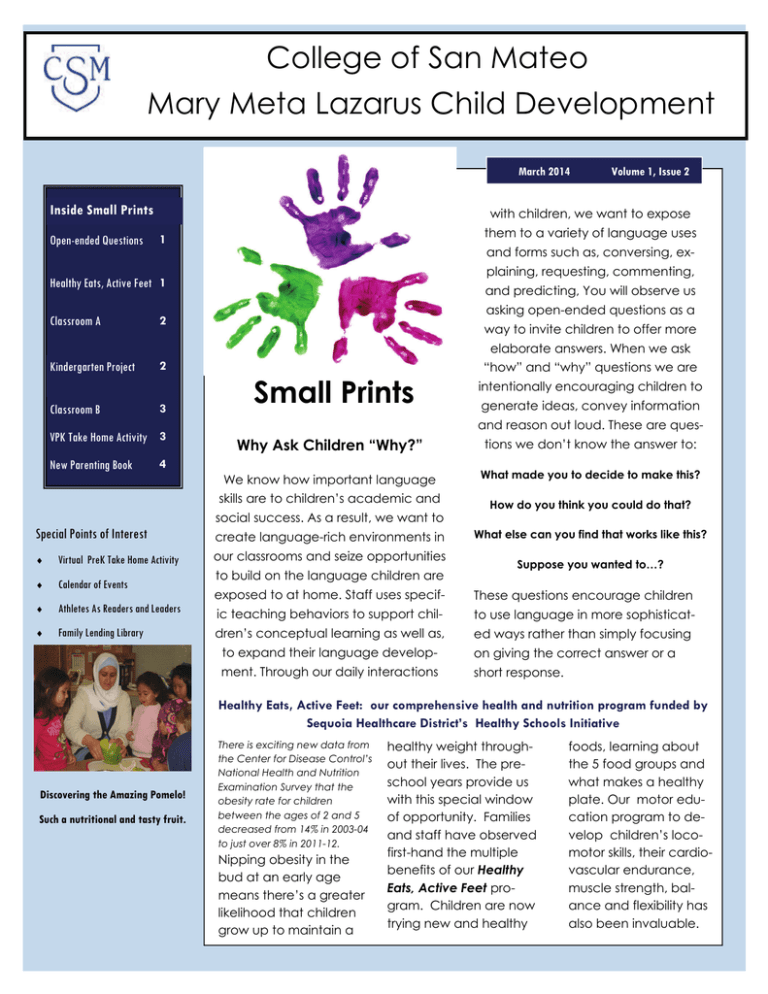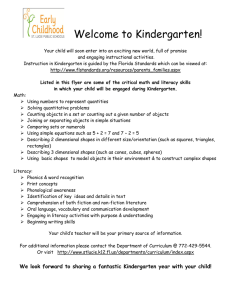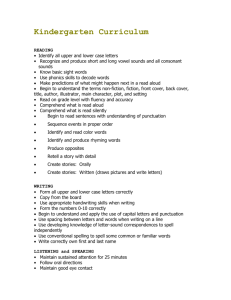College of San Mateo Mary Meta Lazarus Child Development Inside Small Prints
advertisement

College of San Mateo
Mary Meta Lazarus Child Development
March 2014
Inside Small Prints
Open-ended Questions
Volume 1, Issue 2
with children, we want to expose
them to a variety of language uses
1
and forms such as, conversing, explaining, requesting, commenting,
Healthy Eats, Active Feet 1
Classroom A
2
Kindergarten Project
2
and predicting, You will observe us
asking open-ended questions as a
way to invite children to offer more
elaborate answers. When we ask
Classroom B
3
VPK Take Home Activity 3
New Parenting Book
Small Prints
Why Ask Children “Why?”
tions we don’t know the answer to:
We know how important language
What made you to decide to make this?
skills are to children’s academic and
How do you think you could do that?
social success. As a result, we want to
Virtual PreK Take Home Activity
Calendar of Events
Athletes As Readers and Leaders
Family Lending Library
generate ideas, convey information
and reason out loud. These are ques-
4
Special Points of Interest
“how” and “why” questions we are
intentionally encouraging children to
create language-rich environments in
our classrooms and seize opportunities
to build on the language children are
What else can you find that works like this?
Suppose you wanted to…?
exposed to at home. Staff uses specif-
These questions encourage children
ic teaching behaviors to support chil-
to use language in more sophisticat-
dren’s conceptual learning as well as,
ed ways rather than simply focusing
to expand their language develop-
on giving the correct answer or a
ment. Through our daily interactions
short response.
Healthy Eats, Active Feet: our comprehensive health and nutrition program funded by
Sequoia Healthcare District’s Healthy Schools Initiative
Discovering the Amazing Pomelo!
Such a nutritional and tasty fruit.
There is exciting new data from
the Center for Disease Control’s
National Health and Nutrition
Examination Survey that the
obesity rate for children
between the ages of 2 and 5
decreased from 14% in 2003-04
to just over 8% in 2011-12.
Nipping obesity in the
bud at an early age
means there’s a greater
likelihood that children
grow up to maintain a
healthy weight throughout their lives. The preschool years provide us
with this special window
of opportunity. Families
and staff have observed
first-hand the multiple
benefits of our Healthy
Eats, Active Feet program. Children are now
trying new and healthy
foods, learning about
the 5 food groups and
what makes a healthy
plate. Our motor education program to develop children’s locomotor skills, their cardiovascular endurance,
muscle strength, balance and flexibility has
also been invaluable.
Small Prints
Page 2
Room A
Lyle, Lyle., Crocodile! The children in our classroom have been engaged
in active, creative play involving teams and our teachers have been supporting the play by introducing traditional folktales with powerful images
Thanks to Gerald McDermott’s “Monkey, A Trickster Tale from India” and
Judy Sierra’s “The Gift of the Crocodile, A Cinderella Story from the Spice
Islands” the children love to perform dramatizations of these stories. This
play flows into their large motor pursuits as they attempt to balance on
stepping stones to cross imaginary rivers without being eaten by the crocodiles. Making for a truly integrated learning experience. This week, we will
also introduce the children to the cumulative tale of pulling the giant carrot from the ground. It takes a team effort for the family to accomplish the
task.
Creating a Humungous Crocodile
Our Mountain continues to delight the children with the emergence of
mushrooms after all the rains. Everyday the mycologists investigate the humus under the trees for more mushrooms. If none are found, they make
their own with twigs and eucalyptus pods and become the “protectors” of
all mushrooms.
Room A Family Engagement
ÂlâÅ? çâÅ4
XÅÑàç lâÅ4Ê
;aÉÇx ÄxyàA<
ÂfÑ|Çtv{ |á Åç ytäÉÜ|àxAÊ
YtÜ{tÇ
Rana and Lamees graced
our classroom with a demonstration of Jordanian belly
dancing. It was such a fun
way to engage in healthy
physical exercise and the
children loved adorning
themselves with the jeweled
dancing scarves!
Jing, Kaden’s mother, read
books to us in Mandarin at
our Circle Time.
Lucina, Bella’s mother, taught
us how to brush our teeth
properly and the children
now have a renewed interest
in engaging in this healthy
practice.
Center Kindergarten Project
“The transition into kindergarten is an important time in children’s
lives and it influences their later school careers. Children’s early
schooling can be considered a critical period that sets the trajectory
for their future school adjustment.” (Belsky & McKinnon, 1994; Pianta
& Walsh, 1996)
We believe that transition planning and preparation for everyone
needs to start early. There are differences between preschool and
kindergarten that pose challenges for the children. We will be reviewing books about kindergarten, having the children visit their “big
school”, listening to our kindergarten experts (alumni who graduated
last year), and discussing the similarities and differences between
preschool and kindergarten. We will also have an adult kindergarten
panel for our parents to explore the transition experience for families.
Panel of Kindergarten Experts...letting Prekindergarteners know what to expect & showcasing their work.
Volume 1, Issue 2
Page 3
Room B
Make an appointment. The doctors are in! Our classroom continues to be
engaged in doctor and nurse play. The extended roles include patients, receptionists, firefighters, and ambulance drivers. Supporting the concept development of health care professionals, the campus nurse, Beth, came down to give
our teachers flu shots while the children observed and asked questions. We also
had a special guest, Elisabeth (Clark’s mother). She shared information about
her work as a pediatric flight nurse, showed photographs and the children were
in awe of the visuals.
Dr. Gabriel Santos as the resident
doctor and Emmanuel Sanchez
writing out the
prescriptions.
The children are also practicing their writing skills, writing prescriptions and
filling out patient records. While in the examination room, the children are using
new vocabulary “bandages, eye patch, stethoscope, brain, blood vessels, veins
and lungs.” They are demonstrating their new found knowledge of
“noodles” (intestines) and how they help to maintain healthy bodies. Future
plans include learning more about the anatomy and learning to grow germ cultures.
Room B Family Engagement
A big High Five to Angelica’s
father, Tony, for constructing
individual wooden frames so
the children could represent
their hand prints.
Âg{x áâÇ ãÉ~x âÑA \à
{tá t Ä|z{à |Ç {|á ÜÉÉÅ
Alumni, Carolina and
David, Juliana’s siblings,
visited the classroom to
read aloud to our children.
tÇw |à ãÉ~x âÑAÊ
XÄ|étuxà{ UâàÄxÜ
Center Spring VPK Take Home Activity
Create Play Dough Shapes! The purpose of this activity is to help your child
identify shapes and make patterns. Shapes are one category of patterns and
are the foundation for geometry. Help your child learn by identifying and naming shapes and comparing sizes. At the same time, they will develop the muscles
and coordination in their fingers and hands they need for writing as they create
the shapes and measure the ingredients to make the dough
Crystal creates her own play
dough shapes.
Together with your child, measure all of the ingredients into a bowl and mix
thoroughly. Sprinkle some flour on a table or countertop and knead the dough
with your child until it’s smooth. Now, it’s time to make shapes! Use your hands
to form shapes out of the dough and name each shape as you make it. Ask
your child to make the same shapes. Count the sides and corners of each
shape together. Try asking your children some open-ended questions as they
explore such as, “Where have you seen this shape before?”
Mary Meta Lazarus
Child Development Center
Calendar of Events
College of San Mateo
1700 West Hillsdale Blvd.
San Mateo, CA 94402
We scored again!
Athletes As Readers & Leaders
are back by popular demand to
read aloud to our children.
March 7 & March 14—Parenting Workshop Series:
“Plan, Shop, Cook and Save” 1:00 pm to 3:00 pm
April 9—Music Together Event to celebrate the
Week of the Young Child 3:30-4:30 pm
April 23— Practice Fire Drill 10:30 am
April 16th— Graduating Class Photo 10:00 am
April-May— Teacher/Parent Conferences
May 5—Desired Results Parent Surveys
May 16—Crossing the Bridge Ceremony 3:30 pm
THANK YOU TO MIA, TRACK & FIELD AND WOMEN’S BASKETBALL AND RYAN, TRACK & FIELD
Check-Out the New Addition to
Our Family Lending Library
Teachers get their flu shots from Nurse Beth while the children
observe and learn
In our Family Lending Library, we
Her book is filled with examples
have a wide variety of quality
of positive discipline in action. It
children’s books for families to
is “a treasure trove of practical
check out and read aloud to-
advice”. The primary message
gether at home. We also have
conveyed is that the key to pos-
parenting books on a range of
itive discipline is mutual respect,
helpful topics such as, toilet
not punishment. Nelson encour-
learning, understanding chil-
ages us to be firm and kind in
dren’s response to separation &
our approach to limiting setting
divorce, fostering children’s
so children learn creative coop-
healthy self-esteem, encourag-
eration and self-discipline with
ing children’s healthy eating
no loss of dignity.
habits and more. Thanks to one
Check out “Positive Discipline”
and discover ways to diffuse
power struggles, build on your
child’s strengths, hold children
accountable and more…
of our parents, we’ve added a
new book to the library entitled
“Positive Discipline” by Jane
Nelson, Ed. D., a psychologist,
educator and mother of seven!
A Fabulous Resource!!!






